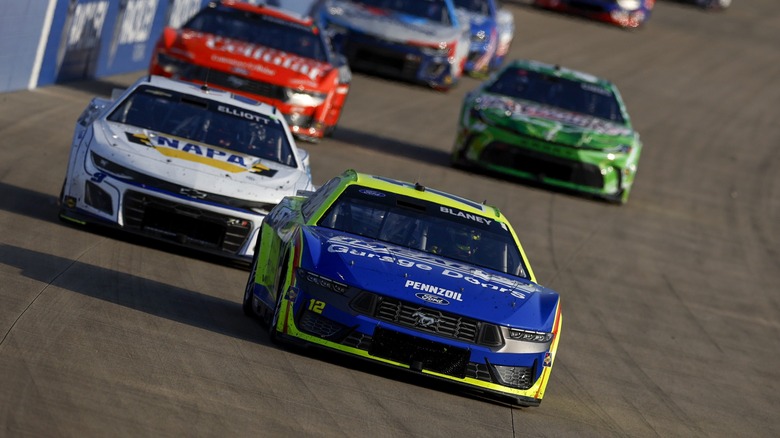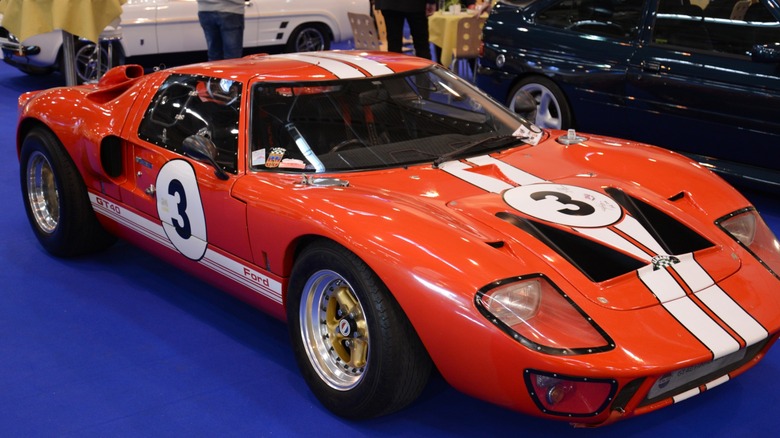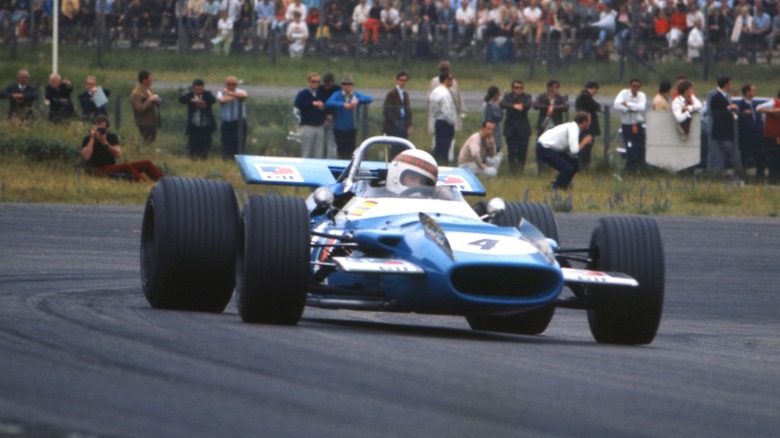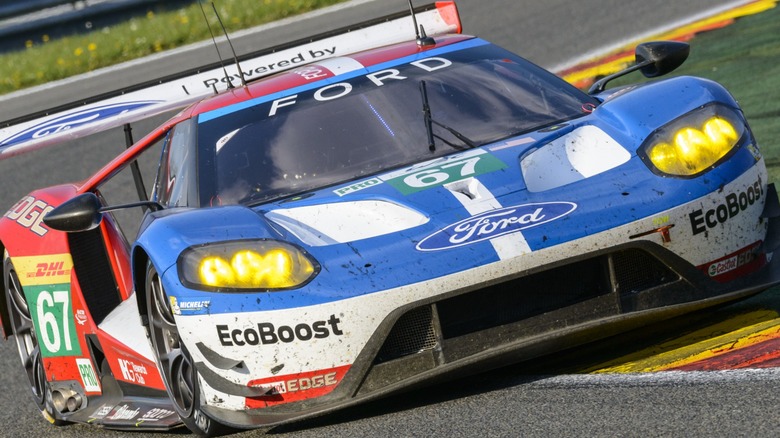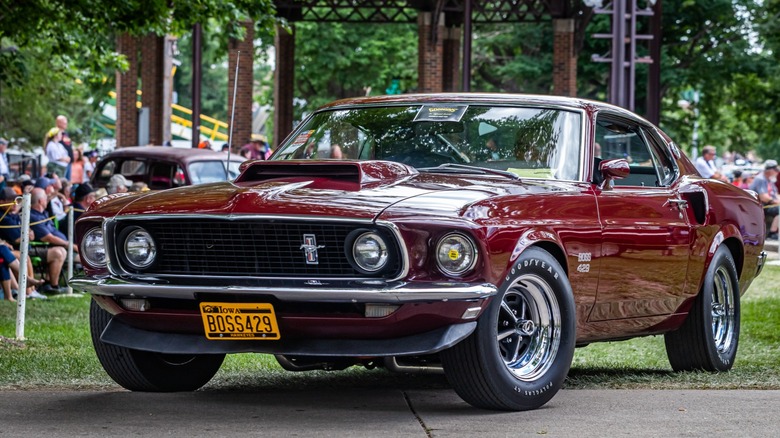6 Of The Most Powerful Ford Engines Ever Put In A Pro Race Car
There's something undeniably special about the sound of a racing engine at full throttle. In that moment, you can hear the result of decades of engineering expertise and the countless hours of work that brought it to life. Ford Motor Company, in particular, has played a major role in shaping motorsport, developing engines that have had a lasting impact on racing and performance engineering.
From the early days of automotive racing, Ford has invested heavily in engine development, creating designs that have influenced both race cars and road cars. Some of these engines have helped secure major victories, while others introduced innovations that set new benchmarks for performance. From Daytona to Le Mans, Ford engines have been tested in some of the most demanding races in the world.
In this article, we'll take a closer look at some of Ford's most powerful performance engines, their success on the track and the road, and how they've helped define the company's motorsport legacy.
Ford 427 FE V8
It's the mid-1960s, and Ford is determined to end Ferrari's six-year reign at Le Mans. After a failed attempt to buy the Italian company, Henry Ford II's mission was to conquer European racing. As a result, Ford developed a 7.0 liter V8 engine that would ignite one of the greatest rivalries in motorsport history.
What set this engine apart wasn't only its massive displacement. While European competitors relied on complex but fragile engines, Ford built on its existing FE-series V8 architecture, modifying it so it could withstand the demands of 24-hour full-throttle racing. The resulting 427 engine blended raw American muscle with cutting-edge racing modifications. That way, it became well-suited for the long straights and high-speed conditions of Le Mans.
With an output exceeding 485 horsepower at 6,400 rpm, the 427 helped the GT40 reach competitive speeds, but performance alone wasn't enough to last a full day of racing. In order to make it durable, Ford engineers reinforced the engine with cross-bolted main bearings, a high-flow oiling system to manage heat, and aluminum water pumps for better cooling.
At the 1966 24 Hours of Le Mans, the GT40s equipped with the 427 finished first, second, and third, securing Ford's first overall win at the event. This victory, which was one of the most iconic moments in motorsport history, started a four-year winning streak that challenged the dominance of European manufacturers and solidified Ford's place in endurance racing history. It was clear proof that American engineering could compete with and surpass the best European manufacturers.
The legacy of the 427 extended beyond the track. The engine's design elements developed for this GT40 MK II program carried over into future Ford performance programs.
Ford 427 SOHC
Sometimes, an engine is so powerful that it never gets the chance to prove itself on the track. That's exactly what happened with Ford's 427 SOHC V8, famously known as the "Cammer." The story of the Cammer begins with Ford's determination to stay ahead in NASCAR. While their standard 427 was already a formidable engine, Ford's engineers knew they needed something extra to maintain their edge. Their solution was to take the 427 block and add single overhead camshafts. This seemingly straightforward modification, combined with other advanced engineering tweaks, created one of the most powerful engines of its time.
In its tamest form, the Cammer churned out 616 horsepower at 7,000 rpm with a single four-barrel carburetor. Opting for dual four-barrel carburetors pushed output to 657 horsepower—numbers that were virtually unheard of in 1964. The engine could rev higher, run harder, and make more power than anything else in NASCAR's paddock.
But before the Cammer could even compete, NASCAR effectively banned it. The organization changed its rules to mandate that all engines used in competition had to be available in regular production cars. Ford couldn't feasibly mass-produce such a sophisticated engine at the time.
However, even though it never turned a wheel in NASCAR, the Cammer found success elsewhere. It dominated the drag racing scene, where its high-revving nature and massive power output made it well-suited for quarter-mile runs. The engine became legendary in the drag racing community, earning a reputation as one of the most potent Ford engines ever created. Even today, surviving Cammer engines are highly coveted by collectors and enthusiasts who wonder what might have been if it had competed in NASCAR.
Ford Cosworth DFV
In 1965, Ford entrusted Keith Duckworth and Mike Costin of Cosworth Engineering with a pretty big challenge: create a groundbreaking Formula 1 engine. The goal was straightforward yet ambitious— design a lightweight, powerful engine that multiple teams could use. The result was an engine that would forever alter the trajectory of Formula 1.
The DFV (Double Four Valve), as the name suggests, was a 3.0-liter V8 design that featured four valves per cylinder and was designed to serve as a stressed member of the car's chassis, meaning the engine itself formed a part of the car's structure. When it debuted in 1967 in the Lotus 49, it delivered around 400 bhp. By the time it retired from F1 in the early 1980s, it reportedly produced up to 500 horsepower at 11,000 rpm.
Beyond raw power, the DFV was equally accessible. Before its arrival, F1 engines were often closely guarded factory secrets, unavailable to private teams. Ford and Cosworth upended this model by offering the DFV to any team that could afford it. This democratization of cutting-edge technology transformed the sport. Judging by the success that followed, it was well worth it. The DFV powered 155 Grand Prix victories, 12 Drivers' Championships, and 10 Constructors' Championships. From 1969 to 1973, every Formula 1 race was won by a car powered by the DFV. That's nearly a five-year monopoly that no other engine manufacturer could break.
The DFV's influence extended well beyond Formula 1. Its design principles, we're talking about the four-valve heads, high-revving capability, and stressed-member concept, became benchmarks for racing engines.
Ford Ecoboost V6
When Ford announced it was bringing a 3.5-liter twin-turbocharged EcoBoost V6 to top-level motorsport, it raised eyebrows. After all, this was a world dominated by V8s and V12s, yet Ford's goal was to rewrite expectations about what a modern racing engine could be. Debuting in the IMSA WeatherTech SportsCar Championship, the EcoBoost defied expectations, delivering over 600 horsepower while maintaining remarkable fuel efficiency.
What makes the EcoBoost special is how it achieved this performance. Instead of relying on large displacement, it utilized advanced twin turbochargers and cutting-edge engine management systems to maximize power from every drop of fuel. The result was V8-level performance combined with superior fuel economy, a balance you rarely see in motorsport.
Very quickly, the engine established itself. The EcoBoost-powered race cars triumphed at prestigious events like the 12 Hours of Sebring and the Rolex 24 at Daytona, demonstrating remarkable speed and endurance. What's even more impressive is how the engine proved it's a reliable track star while being pushed to the limit for hours on end. In endurance racing, finishing is winning, and the EcoBoost showed it could do both.
Beyond its on-track achievements, the EcoBoost V6 represents a shift in the future of racing. With increasing emphasis on sustainability in motorsport, it proves that high-performance engines can also be efficient and eco-conscious. By reducing fuel consumption and emissions without compromising on excitement, the EcoBoost is paving the way for a more sustainable future in racing.
Perhaps the EcoBoost V6's most significant legacy is its influence on Ford's road cars. Technologies developed for the race program have been integrated into production EcoBoost engines, making everyday vehicles more powerful and efficient. This is an example of how motorsport continues to drive innovation that benefits drivers on and off the track.
Ford Boss 429
Remember earlier when we talked about how NASCAR rules prevented Honda's Cammer engine from competing in the championships? Well, Ford got one back this time around. In 1969, NASCAR strictly enforced its homologation rules, which required manufacturers to sell at least 500 cars equipped with their race engines to the public. Ford responded by taking their most powerful NASCAR engine and somehow squeezing it into the Mustang. The result was something that would become one of the most legendary muscle cars ever created, with only 859 units offered in 1969 alone.
Engineering the 429 was no small feat. The engine was so wide that Ford couldn't assemble the cars entirely in-house. Partially built Mustangs were shipped to Kar Kraft, Ford's specialty contractor, where the shock towers and inner fenders were modified to make room for the massive powerplant. The engine itself was hand-built with advanced features like aluminum heads containing semi-hemispherical combustion chambers, a forged steel crank, and unique header-style exhaust manifolds.
Beyond the raw power output, what made the Boss 429 truly remarkable was the innovative technology packed into the engine. The crescent-shaped combustion chambers were ahead of their time, and the dry-deck block design, which eliminated traditional head gaskets by sealing the cylinder heads directly to the block, was a cutting-edge solution that has become a staple in modern performance engineering.
Although the Boss 429's time in NASCAR was relatively short due to changing regulations, its legacy endures as one of the most ambitious engines of the muscle car era. It reminds us of a time when Ford was willing to go to extraordinary lengths to dominate both the track and the street, creating an engine so large and powerful that cars had to be specially modified just to contain it.
Ford FR9
Sometimes, the most impressive innovations come from working within strict limitations, and Ford's FR9 NASCAR engine is a good example. Introduced in 2009, the FR9—short for Ford Racing 9—was Ford's first clean-sheet NASCAR engine design in over 40 years. While NASCAR rules limit these engines to 358-cubic-inches (5.8-liter) push-rod V8 configurations, Ford's engineers found clever ways to push the boundaries of performance.
The FR9 took an unconventional path in its cooling system. Unlike traditional engines that try to run as cool as possible, Ford's engineers deliberately designed this engine to run hot at around 300 degrees Fahrenheit. This might seem counterintuitive, but there's some sound logic behind it. By optimizing the engine to run efficiently at higher temperatures, teams could use more tape on the car's grille to improve aerodynamics without risking overheating.
Although NASCAR teams are notoriously secretive about exact numbers, the FR9 can reportedly produce over 750 horsepower while revving up to 9,000 rpm, all without the help of turbochargers or superchargers. This remarkable output highlights Ford's ability to maximize naturally aspirated engine performance. On top of the impressive power, you also get a pretty reliable vehicle. We all know that NASCAR engines endure relentless stress during races, yet the FR9 has proved that it is capable of withstanding these extreme demands.
Overall, these engines weren't just powerful for their time; they redefined what was possible in racing. Each one introduced groundbreaking technology, achieved record-breaking performance, and showcased the sheer brilliance of the American muscle.
